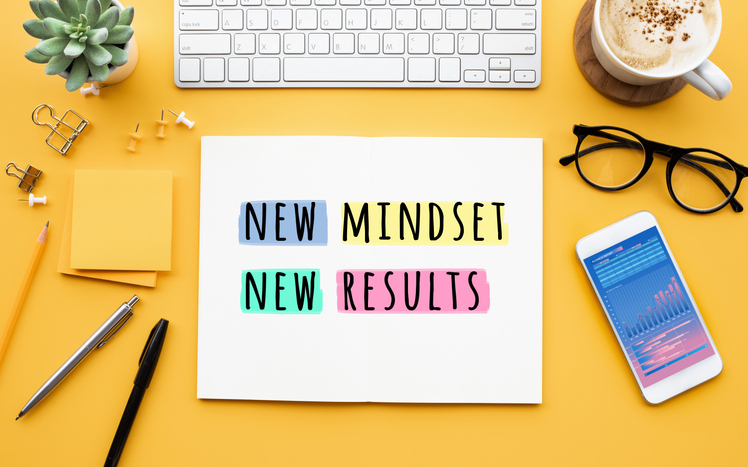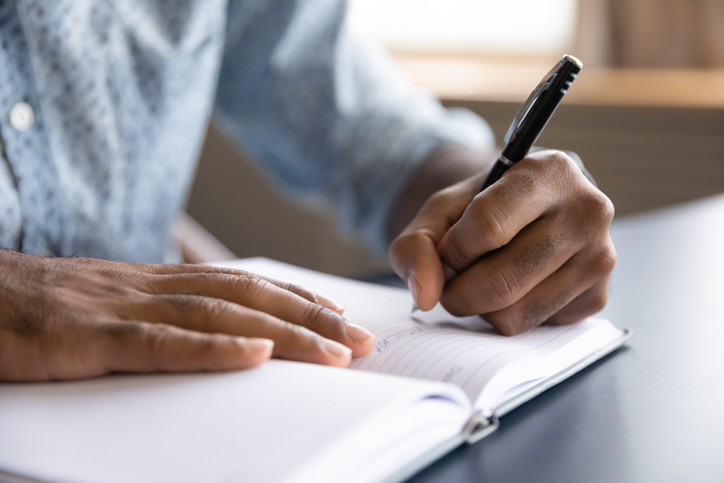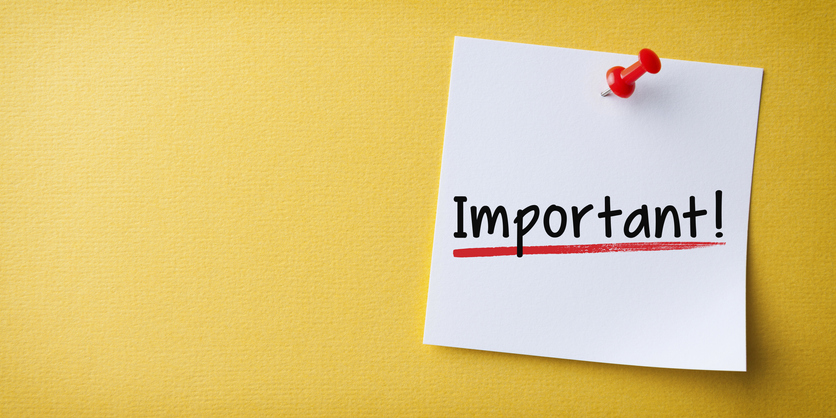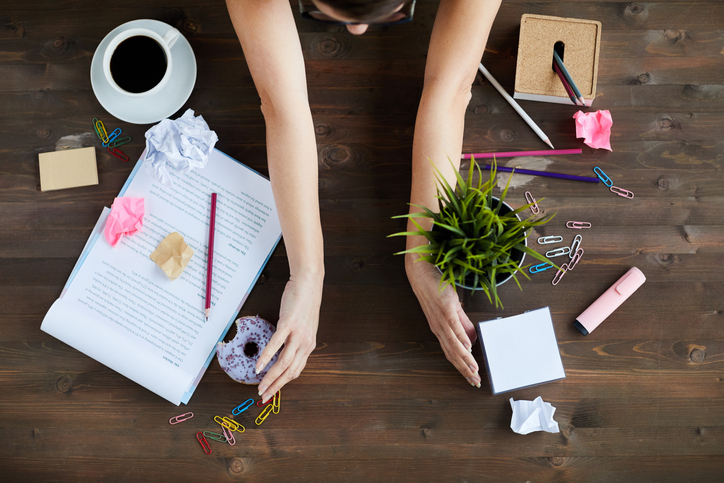If 2020 had you glued to the couch with a never-ending loop on Netflix and then 2021 just kept the couch party going, nobody would blame you. If you’re still in that place of anti-productivity where your only goal is to get through the day — we’re totally here for it. However, IF the symbolic fresh beginning of 2022 has you motivated to get shit done (even if the world still feels like it may fall apart any moment) we have some easy productivity hacks that’ll help you with your new goals — whatever they may be. And since many of us are still working from home it can be even tougher to stay on track. All of the productivity tools below can help you in the long run regardless of where you’re trying to get shit done as well as addressing the more pressing issue of how to be productive at home.

Here at Postable, we’re big fans of productivity and making tasks that were once tiresome, tedious and time consuming — easier than ever. Of course, we’re talking about sending really nice snail mail with a few clicks of a button. Our interest in all things efficiency got us thinking — what other ways can we be more productive? Everyone knows writing to do lists is a must if you’re hoping to accomplish something, but what else can we do to get shit done? As it so happens, there are several simple productivity hacks we can all incorporate into the new year that will help us accomplish all our goals for 2022.
Postable’s FREE online address book organizes your contacts and lets you easily send really nice thank you cards in minutes. Productivity hacks for the win!
The right mindset to get shit done.
In most areas in life our attitude plays a huge role in whether we succeed or allow the bumps along the way to derail our efforts. For a start, you should *want to be productive. If you’re not quite ready to get back to getting shit done, then focusing your attention on self-care that helps you wash the garbage fire that was the last two years off of yourself is an important first step.
Once you’re in a mindset that gets you hyped on being more productive, setting boundaries is the second prerequisite to getting started. Getting shit done at all costs is not a sustainable strategy for productivity. Especially now that many of us are carrying more weight of the world, it’s important to establish ground rules for how much of yourself you’re willing to put into your productivity (more on this later).

Finally, the whole point of incorporating productivity hacks into our lives is to work smarter — not harder. So if you find yourself hunkering down for longer hours or spending more time than you’ve allotted, that’s usually a good time to check-in with your mindset and boundaries. While stepping outside your comfort zone is usually the first step to growth, perpetual discomfort *for the sake of discomfort is not going to get you the results you need.
How to be productive at home — productivity hacks to get shit done.

Working from home can have it’s pros as well as cons — depending on each persons’ individual situation. If you live alone, for example, working from home may well be an advantage: elimination of a lengthy commute and a comfortable working environment (with your pup by your side). On the other hand, if your entire family — kids included — are also doing life from home it’s obviously a more challenging situation. With this said… Be kind to yourself. To circle back to setting boundaries — when you’re mapping out your productivity, just keep in mind what is possible within the context of your own working situation.
Either way, there are still productivity hacks anyone can incorporate on some level into their working from home lives.
Pro tip: Pick one or two of these hacks and try them out. Don’t try to incorporate all of them at once.
Postable’s FREE online address book organizes your contacts and lets you easily send really nice thank you cards in minutes.
1. Note down your distractions to stay focused.
It’s not difficult to get distracted with a million things going on in your immediate environment. Whether it’s your adorable dog begging for attention, your phone buzzing with news alerts or your roommate taking a conference call in the next room — the source of distraction is everywhere. It’s easy to use this as an excuse to put off doing something on your to-do list.
The next time you feel yourself getting distracted by some other less-important task that you may need or want to do — write it down.
What kind of things go on a distractions list and how could this possibly help?

Perhaps your dog reminded you how much time you haven’t been spending with the furry little fella or the news alert brought up the fact you haven’t responded to an important email memo or your roommate’s voice made you think of all the bills you haven’t paid this month. Wherever these distractions led you — write them down.
Have a piece of paper nearby where you can quickly jot down things to add to your to-do list when the time calls for it. These things can include things like the following, but can really be anything that tugs at your mind.
- Walk dog
- Pay electricity bills
- Respond to that memo
2. Keep your phone far away.
Another simple way to avoid hopping on your phone every time you get the urge to scroll Instagram is to keep your phone at bay. Set it at the other end of the room or somewhere out of reach. You can also use apps to ‘lock’ your phone to keep you focused. The Forest app gives you visual incentives to stay off your phone and stay focused — grow your tree while you’re off working on something else.
3. Break things down into bite sized pieces.
You’ve written your to-do list and yet every single day there’s still that one daunting task that remains. You’ve procrastinated, but that’s only because the task seems like an impossible mountain you’ll never climb. Sound familiar? When a task seems so large that you’re not certain where to begin, the first step should be to break it down to bite sized pieces. Baby steps, you know?
Think about what you’ll need to do to get started on the big task and then jot down each sequential step. Now, each one of those steps will serve as their own individual bullet point on your to-do lists. The daunting task is now a combination of several much less intimidating items that you’re far less likely to procrastinate over.
4. Attack the important stuff first.
Speaking of procrastinating — it’s really easy to put off doing the things on our to do list that require a bit more effort. Because of this, the important stuff isn’t attended to. This is neither efficient nor is it helpful. Crossing off easy unimportant tasks off your to do list may feel awesome (and by all means, WAY TO GO), but in effect we’re making ourselves a whole lot less productive.
When deciding where to begin with a to do list — think about what actually needs to be done by the end of the day. Start there. You’ll feel so much better getting these items actually crossed off the list than seeing them again and again and again.
5. Prioritize, prioritize, prioritize!

Speaking of doing the important stuff first — don’t forget to do the next important thing after that. It sounds super simple (and it is), but this productivity tool is often overlooked.
Most of us are well versed in creating daily to-do lists, but the key is to notate priority for the items and arrange them in order of importance. This way we are attacking not only the most important stuff first, but also putting effort into the second most important items as well. If all of the items on our to-do list are prioritized — not only will we feel completely overwhelmed, but nothing will get done.
6. Use tools and outsource for help.
We all want to believe we’re superheroes in disguise, but at the end of the day some of our to do lists are just too much. You’ve attacked the most important stuff first, you’ve stayed focused, but you still need help. And that’s ok. There are a ton of tools out there to help you get shit done. Here are a few to help cross some items off your to-do list.

Sending thank you notes, party invites, birthday cards or just about any other greeting card known to mankind can be as easy as sending an email. Postable has a bewitching selection of greeting cards that can be mailed for you. You can send bulk mailings or single one-off cards with just a few clicks without ever sacrificing quality for quantity. The cards are mailed out in beautiful Kraft envelopes and printed on quality paper.
Use Trello to easily keep up with project management, Slack to keep up with communicating with your team, Toggl to keep track of the time you’re putting in, and Boomerang to painlessly manage your emails.
7. ‘Batch’ recurring tasks.
Gayle Bu, a certified money, Marketing and Soul Coach® with a focus on productivity and time management, suggests batching similar tasks to be completed in one go instead of breaking them up.
“Batch” recurring tasks such as writing and recording videos/podcasts. Taking into consideration that it takes an average of 23 minutes for most people to switch between tasks, you’ll find that you get more accomplished in a shorter period of time when you batch recurring tasks. For instance, if you have to put out one video per week to your audience, it’s much more effective to do hair/makeup/setup and record four videos back-to-back once a month than it is to repeat that same process every.single.week. The same goes for recording, writing or editing content. You get in a zone and can pump out deliverables faster and with less distraction than you would if you were spacing those same tasks throughout the month.“
8. Declutter your surroundings.
The more things you have around you that stimulate your senses, the harder it is for you to get shit done. Multitasking is actually not a thing and the more your brain has to filter through the senses, the more strained it is for attention on that one thing you’re trying to complete.

Shefali Raina, a NYC based High Performance Coach says “studies show that our brains are incapable of doing more than one complex task at the same time and our unintentional multitasking takes more mental energy, leaves us drained, slows us down and reduces our productivity and efficiency.”
So something as simple as having a clean desk and working space can make a big effect over time. Spend 10 minutes at the end of the day tidying up your desk so that you start your morning with clarity. Have left over items on your otherwise crossed off to-do list? Make a new one. De-clutter your lists by making new ones that don’t have old information on them. If you want to get even deeper with this habit — de-clutter your mind by incorporating daily meditations. Talk about focus!
9. Take scheduled breaks.
There’s no way to productively work on anything — regardless of who you are — for eight hours straight. And chances are, you’re already taking breaks here and there throughout the day by checking Facebook or scrolling through Instagram. The thing is, these breaks are more like distractions. They weren’t planned and end up taking more time than you intended. Instead, if you plan on having breaks in your schedule — you can come to a stop in your work and rest your mind for a short while before getting back at it. You’ll spend the time you intended and it won’t be a distraction keeping you from getting things done.
10. Take time to re-fuel.
And we don’t just mean food. Take time for yourself or your productivity will be low no matter how many new habits you implement. Make sure you’re getting enough sleep — coffee is amazing, but it’s not going to magically give you back 8 hours of sleep. Want to be at your best? Do the best you can to take care of yourself first.
11. Get and stay motivated!
Motivation is like hygiene — if you don’t keep up with it, you’ll end up smelly and procrastinated. Ok, so maybe that’s not how it goes, but you get the idea. Nothing lights a fire under our ass like a good dose of motivation. Want to get things done in 2022 — keep yourself motivated. That means daily or weekly doses of applied motivation.
Watch that movie that always hits you in the gut, listen to your hype song in the morning before starting your work day, read books by successful people in your field, listen to podcasts that get your fire burning, or watch a motivating TED talk. Whatever you have to do — keep yourself properly motivated.
12. Face your fears by writing them down.
Who would’ve thought that facing fears would help us get shit done? Lizzie Benton, a specialist establishing effective company cultures, has an interesting approach to getting productive.
“Procrastination is the enemy of productivity, but there’s often a reason you’re putting off that task or delaying the start on a project. The truth is your brain is telling you all the reasons you shouldn’t start, and before you know it you’re blinded by small fears that are just pushing the task further out of your reach. Self-doubt is the biggest killer of productivity. We think we’re not good enough, or believe we’re going to make a total mess of it. However, rather than you let your fears pick away at you, face them.
Sit down with a sheet of paper, and write down all your fears. Every single one of them, and get all your emotion on the paper. Yes, I’ll even let you put a few swear words in there.
Once you’re done and feel that all of it is out on paper, read it out loud. You may find this strange, but quite literally hearing these words out loud removes their power, and instead there will be a voice inside your head that tells you it’s all rubbish.
Only by tackling our fears head-on can we move on from them and enjoy the challenge of the task.”
13. Learn to say ‘no’.
If we accept responsibility for everything, nothing will get done. In the same way that if everything is a priority, nothing is. By saying ‘no’ we’re setting boundaries on the tasks that we can *actually handle. This way we can complete the tasks on our to-do lists with competency and a sense of pride.
It’s easy to feel pressured to say yes to every project that comes our way, but prioritizing and setting boundaries will help to pull focus on the items that are worth your time.
The not-so-secret, but often overlooked productivity hack anyone can do: mindfulness.
Sarah Vaynerman, CEO of Work From Om®, a NYC-based company that has been bringing meditation, yoga and mindfulnesses programming to workplaces since 2014 — gave us some great tips for just about anyone trying to get productive.
Digital detoxes may be all the rage these days, but for most of us it is as unrealistic to disconnect entirely as it is to survive through a juice cleanse. Instead, adopt the sustainable Work From Om® Digital Diet by setting rules around your own interactions with technology. From designating screen-free time to turning off unnecessary notifications, you can eliminate stressful stimuli, increase your ability to focus, and profoundly improve your mental well-being. We’ve cherry picked some of our most accessible tips to share with you below.

1. Wake with an alarm clock that’s NOT your phone (and leave your phone in another room).
When was the last time you woke up and took a shower, had breakfast or even let your feet hit the bedroom floor before exposing yourself to a screen? When the first thing you reach for is your smartphone, you’re automatically subjected to checking notifications, scrolling through social media and reading headlines as soon as you wake up – it’s just too easy! Use a regular alarm clock and allow your mind some space to come into its own consciousness before subjecting your attention to the outside world.
2. Pad your evenings with screen-free time.
How often do you find yourself relying on your phone, laptop or TV in bed to fall asleep at night, eyes falling heavy with strain before succumbing to exhaustion? The blue light given off by LED screens prevents our brains from releasing melatonin, the hormone that tells us it’s time to sleep. This means it takes us longer to get into a nice, restful sleep, which can mess with our bodies’ internal clocks. Designating anywhere from 10 minutes to an hour (ideal) of screen-free time before you sleep can do wonders for your brain.
3. Turn off non-vital notifications (we’re looking at you, Facebook).
Do you absolutely need to have social media (or shopping, political news, etc.) notifications light up your phone every five minutes? If your reactive answer is yes, ask yourself why. Unless it has to do with your job or your health/safety, it’s probably time to reconsider. Notifications have trapped us in a loop of constantly picking up our phones and take us away from what’s happening right in front of us. The biggest offenders are the social apps that we use the most, like Facebook, Instagram and Twitter, which we tend to check out of habit even without being prompted.. Turn off your smartphone notifications for these apps. You’ll get your fix through checking anyway when you’re bored or looking for something specific, and detaching from the leash of notifications will yield a feeling of freedom that one must experience to fully appreciate.
4. Designate phone-free zones and situations.
We are in a day and age where being completely present – with ourselves and also with the people around us – takes a little extra effort, so it’s up to us to make it happen. One way to promote this is to establish phone-free spaces and conditions, and we recommend doing so in the places that matter most. Perhaps you can leave your phone at home during your daily jog, designate a no-phones rule for a weekly meeting at work or agree that dinners with your partner/kids/best friend are phone-free situations. When we make the effort to eliminate distractions from life’s precious moments, we are able to experience them more fully and improve relationships with others, our work, and ourselves.
5. Observe the “40-10-10 Rule” for your most productive hours.
Inspired by the Pomodoro Technique, a popular time-blocking method developed in the 1980s, we designed the 40-10-10 rule as a modern-day solution for a full hour of productivity, break and communication. It calls specifically for 40 minutes of dedicated work on one task, 10 minutes to take a break, and 10 minutes to respond to any missed texts, emails or notifications. It’s no secret that we have a lot to get done in a single day, so it’s tempting to work on a little bit of each thing all at once. But multitasking has shown to increase the production of cortisol, the stress hormone, in our brains. It leaves us scattered, thinking about too much and forces our brains to work harder than doing one thing at a time. We can be incredibly more effective if we focus on one task, and block time to recharge and catch up. Break your time down and use it effectively. We are confident you will quickly see positive results.
Use these tools to get yourself back in the driver’s seat, take control of your own mind, thoughts and how you use your time. The first step is being aware of how we are affected by the world around us, and determining how to effectively move forward.